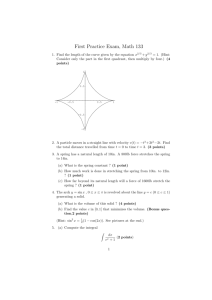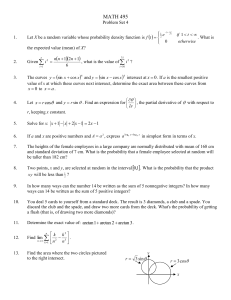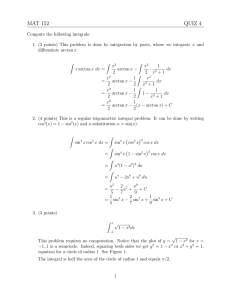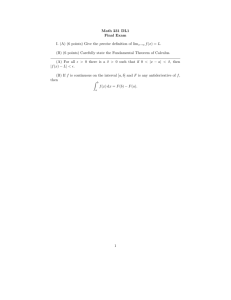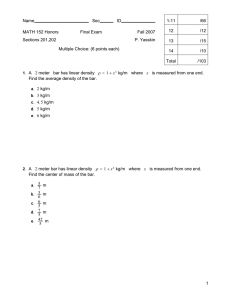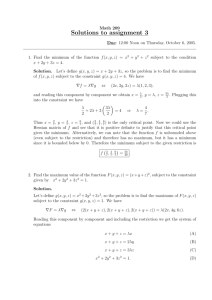Calculus 1 Exam - University of Waterloo
advertisement
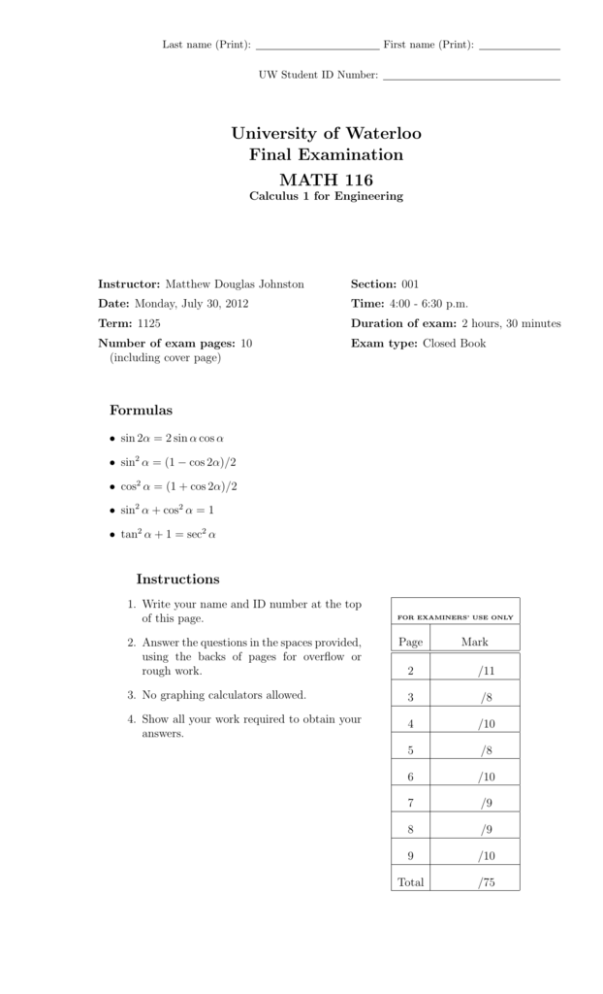
Last name (Print): First name (Print): UW Student ID Number: University of Waterloo Final Examination MATH 116 Calculus 1 for Engineering Instructor: Matthew Douglas Johnston Section: 001 Date: Monday, July 30, 2012 Time: 4:00 - 6:30 p.m. Term: 1125 Duration of exam: 2 hours, 30 minutes Number of exam pages: 10 (including cover page) Exam type: Closed Book Formulas • sin 2α = 2 sin α cos α • sin2 α = (1 − cos 2α)/2 • cos2 α = (1 + cos 2α)/2 • sin2 α + cos2 α = 1 • tan2 α + 1 = sec2 α Instructions 1. Write your name and ID number at the top of this page. 2. Answer the questions in the spaces provided, using the backs of pages for overflow or rough work. FOR EXAMINERS’ USE ONLY Page Mark 2 /11 3. No graphing calculators allowed. 3 /8 4. Show all your work required to obtain your answers. 4 /10 5 /8 6 /10 7 /9 8 /9 9 /10 Total /75 MATH 116 Final Exam, Spring 2012 Page 2 of 10 Name: 1. Miscellaneous Topics 1 (a) Consider the functions f (x) = x2 − 1 and g(x) = √ . x [2] (i) Find (f ◦ g)(x). What is its domain? [2] (ii) Find (g ◦ f )(x). What is its domain? [3] (iii) Set h(x) = (f ◦ g)(x) and find h−1 (x). What is its domain? (Hint: Be careful to consider the domain of h(x) and how it relates to the range of h−1 (x).) [2] (b) Consider the Heaviside function given by 1, H(x) = 0, for x ≥ 0 for x < 0. State the following as a piecewise defined function: f (x) = −x + |x|H(x). [2] (c) Set-up the partial fraction decomposition of f (x) = x2 + 1 . (2x − 3)(x − 1)2 (x2 + 4) Do not attempt to evaluate it! MATH 116 Final Exam, Spring 2012 Page 3 of 10 Name: 2. Short answer questions (a) Answer the following definition questions: d f (x). dx [1] (i) State the formal definition of the derivative [1] (ii) Suppose f (x) is continuous on an interval [a, b], f (a) < 0 and f (b) > 0. Name the theorem which allows us to conclude that there is a c ∈ (a, b) such that f (c) = 0. [1] (iii) Suppose f (x) is continuously differentiable in the interval (a, b). Name the theorem which allows us to conclude that there is a c ∈ (a, b) such that f 0 (c) equals the average rate of change over the interval. (b) Evaluate the exact values of the following: [1] (i) arcsec(2) (Draw the triangle for full marks) [2] (ii) sin(arctan(2/3)) [2] (iii) p0 (0) given that p(t) = (Draw the triangle for full marks) 1 , r(0) = 2, and r0 (0) = −4. r(t) MATH 116 Final Exam, Spring 2012 Page 4 of 10 Name: 3. Limits Evaluate the following limits: √ x4 − 1 + x 4x2 − 1 [3] (a) lim [4] x1 1 (b) lim x→∞ x [3] (c) lim x→∞ cos2 (7t) − 1 t→0 t sin(4t) sin(kt) = k.) t→0 t (Hint: You may use the fact that lim MATH 116 Final Exam, Spring 2012 Page 5 of 10 4. Derivatives Find f 0 (x) = dy for the following: dx [3] (a) f (x) = √ [3] (b) ey = 1 1 + e2x x y Z [2] (c) f (x) = x x2 √ cos( s) ds, x>1 Name: MATH 116 Final Exam, Spring 2012 Page 6 of 10 Name: 5. Approximation Many problems in mathematics do not have explicit solutions; instead, we must rely on approximations. Consider the following problems. [4] (a) Use linear approximation to estimate the value of arctan(1.02). (Hint: Note that π arctan(1) = .) 4 [4] (b) Use Newton’s Method to estimate the value of arctan(1.02). It is sufficient to compute the first iterate x1 (i.e. apply Newton’s Method once). (Hint: The exact value of arctan(1.02) is the root of f (x) = tan(x) − 1.02 nearest x0 = π/4.) Newton’s Formula: xn+1 = xn − [2] f (xn ) f 0 (xn ) (c) Set up the Riemann sum for evaluating the area below the curve f (x) = ln(x) between the bounds x = 1 and x = 2 using the right end-point of each interval. Do not attempt to evaluate the sum! MATH 116 Final Exam, Spring 2012 Page 7 of 10 Name: 6. Curve Sketching An important application of the tools developed in this class is curve sketching. Con2 sider the function f (x) = xe−x /2 . [2] (a) Find all vertical and horizontal asymptotes of f (x). (Hint: Consider writing the exponent in the denominator and using L’Hopital’s rule.) [1] (b) Determine all roots of f (x). [2] (c) Given that f 0 (x) = (1 − x2 )e−x /2 , determine all critical points and the intervals where f (x) is increasing and decreasing. [2] (d) Given that f 00 (x) = x(x2 − 3)e−x /2 , determine all points of inflection and the intervals where f (x) is concave up and concave down [2] (e) Based on the information from parts (a)-(d), sketch the (x). Label all √ graph of f−1/2 3 ≈ 1.7, e ≈ 0.6 and roots, critical points, and points of inflection. (Hint: √ −3/2 3e ≈ 0.4.) 2 2 y 2 1 x -5 -4 -3 -2 -1 1 -1 -2 2 3 4 5 MATH 116 Final Exam, Spring 2012 Page 8 of 10 Name: 7. Integration Evaluate the following integrals: Z [2] (a) cos(ax) dx, Z [3] (b) 1 a 6= 0 √ 2x 1 + x2 dx 0 8. Area between the curves [4] Determine the area of the region bound by the functions f (x) = (Hint: f (x) lies above g(x) in the relevant interval.) x2 and g(x) = x2 − 2x. 2 MATH 116 Final Exam, Spring 2012 Page 9 of 10 Name: 9. Optimization [5] After a long illustrious career teaching mathematics, Matthew decides to retire to a peaceful life of recreational farming. He wants to fence in a rectangular plot of land adjacent to a road (leaving the side facing the road unfenced). If he decides to plant 800 m2 worth of crops, what are the dimensions of the field which minimizes the amount of fencing he needs to purchase? Farm x Area = 800 m2 x y 10. Related Rates [5] Suppose you are observing a cycling race around a circular track of radius 1 km. Suppose the leader is travelling in the counterclockwise direction with constant velocity 30 km/h. If you are watching the race from the western-most point on the track (pictured below), how quickly is the leader moving away from you when he is at the northern-most point on the track? (Hint: A constant counterclockwise velocity of 30 km/h around a circle dθ = −30 radians/h.) of radius 1 km corresponds to dt y (x2,y2)=(cos(θ),sin(θ)) -x (y )12 + (x 2 2= D (x1,y1)=(-1,0) )2 -2 y 1 dθ =-30 dt r=1 θ= π 2 x MATH 116 Final Exam, Spring 2012 Page 10 of 10 Name: THIS PAGE IS FOR ROUGH WORK
